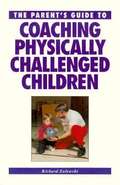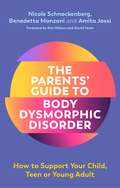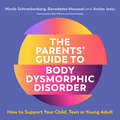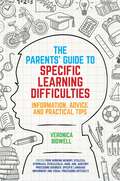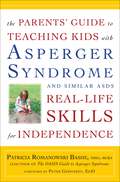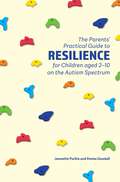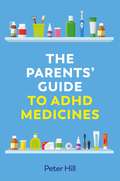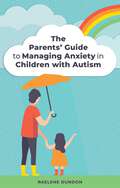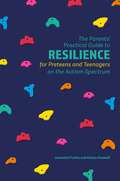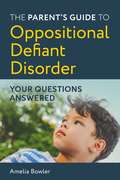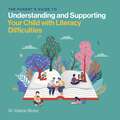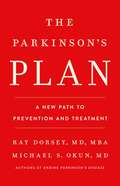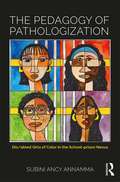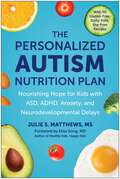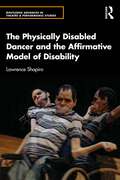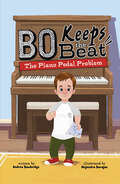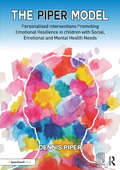- Table View
- List View
The Parents Guide to Coaching Physically Challenged Children
by Richard ZulewskiHandbooks in The Better Way Coaching Kids series serve as the perfect step-by-step introductory primers for parents and coaches. Written in an easy, conversational style, these books cover all the basic skill-building techniques, rules of the games, proper equipment and first aid. These guides focus on team spirit, the importance of fair play and overall fun. Special attention is paid to developing a child's confidence and self-esteem, -- all important keys to success.
The Parents' Guide to Body Dysmorphic Disorder: How to Support Your Child, Teen or Young Adult
by Amita Jassi Nicole Schnackenberg Benedetta MonzaniThe first book offering support for parents and carers of children and young people with Body Dysmorphic Disorder (BDD), this guidebook explains the condition as well as the impact that it may have in education settings, family life and socialisation.The guide begins by explaining how and why BDD emerges, before moving onto an exploration of how the mental health condition presents itself emotionally, psychologically, physically and behaviourally. It then offers practical advice and guidance for parents and carers on talking to their child about BDD, seeking professional treatment, considering medication, managing social media use, working with schools to build a recovery team and more.The Parent's Guide to Body Dysmorphic Disorder is an essential guidebook for parents of children of children and young people with BDD.
The Parents' Guide to Body Dysmorphic Disorder: How to Support Your Child, Teen or Young Adult
by Amita Jassi Nicole Schnackenberg Benedetta MonzaniThe first book offering support for parents and carers of children and young people with Body Dysmorphic Disorder (BDD), this guidebook explains the condition as well as the impact that it may have in education settings, family life and socialisation.The guide begins by explaining how and why BDD emerges, before moving onto an exploration of how the mental health condition presents itself emotionally, psychologically, physically and behaviourally. It then offers practical advice and guidance for parents and carers on talking to their child about BDD, seeking professional treatment, considering medication, managing social media use, working with schools to build a recovery team and more.The Parent's Guide to Body Dysmorphic Disorder is an essential guidebook for parents of children of children and young people with BDD.(P) 2020 Hodder & Stoughton Ltd
The Parents' Guide to Specific Learning Difficulties: Information, Advice and Practical Tips
by Veronica BidwellPacked full of advice and practical strategies for parents and educators, this book is a one-stop-shop for supporting children with Specific Learning Difficulties (SpLDs). Part one introduces a spectrum of SpLDs, ranging from poor working memory, dyslexia, dyspraxia, dyscalculia, through to ADHD, Autism Spectrum Disorder (ASD), Auditory Processing Disorder (APD), Specific Language Impairment and Visual Processing Difficulty. It explains clearly what each difficulty is, how it can affect a child's learning and how to help a child to succeed despite their difficulties. Part two includes a host of tips, tools and strategies to support your child's efforts in areas such as reading, writing, spelling and handwriting, as well as advice on motivation, confidence and managing life's setbacks. Written by an experienced Educational Psychologist, this is the perfect guide for parents and carers who are looking for ways to support their child's learning, as well as for educators and teachers looking for advice on how to differentiate lessons and motivate pupils with SpLDs.
The Parents' Guide to Teaching Kids with Asperger Syndrome and Similar ASDs Real-Life Skills for Independence
by Patricia Romanowski Peter GerhardtThe definitive resource for teaching kids with Asperger syndrome the life skills that build independence, confidence, and self-esteem. Children with autism spectrum disorders learn differently. Our kids' choices are too often limited and their paths to success restricted, not by a lack of intellectual ability but by deficits in acquiring, applying, and generalizing basic life skills. Success in school, at home, on the playground, and beyond depends on mastering countless basic living skills that most other kids just "pick up" almost by osmosis. This book shows parents how to teach these so-called easy skills to complex learners. This is the first book for parents and caregivers of kids with Asperger syndrome and similar learning profiles that features strategies based on applied behavior analysis--the most widely accepted, evidence-based, and effective teaching method for learners with ASDs--including how to: -Identify critical skills appropriate for your child's age--how to teach them and why-Implement new techniques that can replace, mimic, prompt, override, or impose missing order on your child's learning style -Design a curriculum for your child that reduces reliance on prompts (including parents) and promotes new learning, new behaviors, and independenceFrom the Trade Paperback edition.
The Parents' Practical Guide to Resilience for Children aged 2-10 on the Autism Spectrum: Two to Ten Years
by Jeanette Purkis Emma GoodallChildren and young people with autism have the capacity to be independent and resilient which can help them live independently or be supported to live a fulfilling life and reach their full potential. This book empowers parents of autistic children aged two to ten to help them promote resilience in their child. Full of suggestions and simple activities, this easy-to-use resource will help guide parents on how to build the foundations of resilience and independence for situations such as school, new environments and relationships with other children. It includes information about the main developmental stages for children on the autism spectrum, and will take parents through life events and milestones at different ages and identify where difficulties and barriers to resilience may arise and how to address them.
The Parents’ Guide to ADHD Medicines
by Peter HillThis reassuring guide explains prescribed ADHD medicines for children in clear, everyday language. Based on questions the author has received from countless families in his work as a Consultant Psychiatrist, the expert information in this book answers the most pressing questions a parent will have about ADHD medicines: how they work, what they do, what is available and how to talk about them to your children. This book sheds light on why not all medicines are easily available, the differences between certain medications and their level of effectiveness, all based on scientific evidence. This information will support parents in discussions with medical professionals, explaining the practicalities and demystifying the terminology around medication and treatments. The book also provides insights into the decisions behind prescribing certain medicines and how they should be taken. Armed with this guide, parents - as well as teachers and others working with kids with ADHD - can feel confident and assured when their child is prescribed treatments for ADHD.
The Parents’ Guide to Managing Anxiety in Children with Autism
by Raelene DundonThis guide for parents is a complete introduction to autism and anxiety. Drawing on the author's clinical experience working with children and their families, it provides parents and carers with everything they need to know to help support their child. It covers the basics such as what anxiety is, how it manifests behaviourally and why it is common in autism, before presenting CBT-informed practical strategies for managing a common range of anxieties: separation, social, performance, phobias, and generalised anxiety. It also has chapters dedicated to related behaviours including Pathological Demand Avoidance (PDA) and advice on managing meltdowns.This is a clear, concise and practical guide that answers any questions that parents and carers might have about anxiety and provides support strategies to help children with autism manage a range of anxieties.
The Parents’ Practical Guide to Resilience for Preteens and Teenagers on the Autism Spectrum
by Jeanette Purkis Emma GoodallThis book empowers parents of autistic young people aged 11 to 20 to help them promote resilience in their child. Full of suggestions and simple activities, this easy-to-use resource will help guide parents on how to build the foundations of resilience and independence for situations such as negotiating sexuality and relationships, entering employment or living away from home. It includes information about the main developmental stages for preteens and teens on the autism spectrum, and will take parents through life events and milestones at different ages and identify where difficulties and barriers to resilience may arise and how to address them.
The Parent’s Guide to Oppositional Defiant Disorder: Your Questions Answered
by Amelia BowlerThis parenting guide to ODD offers expert information on your child's condition, provides insight and empathy to what they are going through, and equips and empowers you to make practical changes in your parenting approaches. It provides an overview of tried-and-tested techniques from a mother of a child with ODD to support you in response to typical questions you may have:· "Why is my child acting this way?"· "What does this say about me?"· "Why doesn't my child respond to punishment or reward?" · "What am I supposed to do next?"Overall this book teaches you how to avoid common mistakes in responding to ODD, the crossover with similar diagnoses such as ADHD and how to distinguish the disorders, how to improve your own resilience and confidence to communicate effectively with your strong-willed child, and start rebuilding the relationship you have.
The Parent’s Guide to Understanding and Supporting Your Child with Literacy Difficulties
by Valerie MuterWhy do some children experience literacy difficulties?How can I identify if my child finds reading and spelling challenging?What is the best way to support them at home?As a parent, it can be difficult to identify how your child's literacy difficulties may present in a home setting and supporting the child with literacy difficulties doesn't end at the school gates!Child psychologist, Valerie Muter, goes beyond the classroom to offer a wealth of resources for parents to use at home to help engage their child in reading and writing. From giving you a guidance on how to communicate with teachers about your concerns and requesting screenings and assessments to giving you lots of tips and tricks that you can implement at home to support your child's growth, this is the ultimate guide to answer all of the questions you might have about literacy difficulties and more.
The Parkinson's Plan: A New Path to Prevention and Treatment
by Michael S. Okun Ray DorseyA groundbreaking prescriptive guide to preventing and fighting Parkinson&’s disease that &“meets this moment with science, clarity, and a path forward&” (Sanjay Gupta, chief medical correspondent, CNN) In The Parkinson&’s Plan, two doctors on the cutting edge of Parkinson&’s research detail the steps necessary to prevent, slow, and treat this debilitating condition. They show readers how to prevent the disease through the food we eat, the water we drink, the air we breathe, and the lifestyles we live. They introduce the &“Parkinson&’s 25,&” the most detailed checklist ever created to allow anyone to lower their risk of Parkinson&’s. They interview the world&’s top scientists, clinicians, and thought leaders in the Parkinson&’s field to offer a detailed plan for treatment that includes cutting-edge methods and recent technological and medical advances. The Parkinson&’s Plan takes the next step in winning the battle against Parkinson&’s, presenting a clear road map with the strategies and tactics necessary to create a world where the disease is increasingly rare and the treatments are more successful.
The Pedagogy of Pathologization: Dis/abled Girls of Color in the School-prison Nexus
by Subini Ancy AnnammaWINNER OF THE 2018 NATIONAL WOMEN'S STUDIES ASSOCIATION ALISON PIEPMEIER BOOK PRIZE Linking powerful first-person narratives with structural analysis, The Pedagogy of Pathologization explores the construction of criminal identities in schools via the intersections of race, disability, and gender. amid the prevalence of targeted mass incarceration. Focusing uniquely on the pathologization of female students of color, whose voices are frequently engulfed by labels of deviance and disability, a distinct and underrepresented experience of the school-to-prison pipeline is detailed through original qualitative methods rooted in authentic narratives. The book’s DisCrit framework, grounded in interdisciplinary research, draws on scholarship from critical race theory, disability studies, education, women’s and girl’s studies, legal studies, and more.
The Personalized Autism Nutrition Plan: Nourishing Hope for Kids with ASD, ADHD, Anxiety, and Neurodevelopmental Delays
by Julie S. MatthewsCreate the right diet to support your child with autism or other neurodevelopmental delays through this step-by-step guide to optimal nutrition for their unique needs.If your child with autism spectrum disorder struggles with common symptoms such as irritability, anxiety, stimming, or gastrointestinal upset, you are not alone—and you are not powerless to help. This groundbreaking book offers the first personalized approach to help improve these disruptive symptoms through your child&’s diet, supplying you with the information and resources you need to holistically help them thrive. Certified nutrition consultant Julie Matthews pairs more than 20 years of clinical experience with practical advice and an attainable and adaptable 12-step plan for effectively addressing the symptoms of autism spectrum disorder, ADHD, ADD, Tourette&’s syndrome, Down syndrome, learning delays, anxiety, aggression, and defiant disorders. Matthews illustrates the underlying biochemical factors that cause these symptoms, and explains how therapeutic diets and nutritional supplements can have profound benefits for your child&’s body and brain. This scientifically proven program includes: Common and impactful diets to implement Adjustable daily meal plan ideas for each diet Detailed lists of key foods and nutritional supplements 50 nourishing and picky eater–approved recipes Symptom questionnaires for determining the right diet Just as every child with autism spectrum disorder is unique, there is no one-size-fits-all diet recommendation. The Personalized Autism Nutrition Plan is tailored yet flexible, empowering you with tools to drastically improve your child&’s well-being and help them thrive—with food as medicine.
The Physically Disabled Dancer and the Affirmative Model of Disability (Routledge Advances in Theatre & Performance Studies)
by Lawrence ShapiroThis volume investigates the contributions and achievements of the physically disabled dancer while challenging and recognizing the inherent inequities in the field of integrated dance in the UK which currently places greater emphasis on the learning‑disabled performer. This is the first book ever written by a physically disabled dancer on the subject of physically disabled dancers. Inherent in this examination is the model of examining disability that is most closely associated with the disability arts movement which is the ‘affirmative model of disability’. This model is defined as an approach to disability in which the disabled person is neither an object of medical care nor a victim of social indifference but a self‑respecting, autonomous individual in which their disability is a positive and affirming aspect of their self‑identity. This book, based on interviews with physically disabled dancers, choreographers, academics and arts producers all in a UK context, combines a wide range of perspective of disability dance together with the intellectual rigour of disability studies to produce a new definition of the physically disabled dancer as an affirming, positive, indispensable practitioner of contemporary performance art. The volume pioneers perspectives of the physically disabled dancer prioritizing first‑person accounts from the performers themselves to produce an unprecedented contribution to the study of disability arts from a uniquely British perspective.This book will offer educators as well as arts and cultural professionals a critical resource for facilitating work by and in alliance with practitioners of integrated dance.
The Piano Pedal Problem (Bo Keeps the Beat)
by Andrew BambridgeBo really wants to take piano lessons like his older brother Jason. But there are two problems—his mom says he’s not ready, and his feet can’t reach the foot pedals because of his achondroplasia. But Bo knows that where there’s a problem, there’s a solution! With determination and the help of a kind teacher, Bo tackles the piano problem, and his feet and fingers finally feel the music! Musician, educator, and actor Andrew Bambridge (Pixels) offers a charming chapter book series about a boy named Bo who, like Andrew, has achondroplasia and has always loved music.
The Piper Model: Personalised Interventions Promoting Emotional Resilience in children with Social, Emotional and Mental Health Needs
by Dennis PiperThis book is intended to be both a practical evidence-based tool and an awareness-raising resource for teachers, teaching assistants, mentors and all adults who work with children and young people who present as 'extremely challenging' in the school context. In every school there are a small number of pupils, less than five percent, who take up more than fifty percent of the staff's time. This book provides school staff with an approach to personalised interventions that enable those children or young people to build life-long resilience skills.
The Playground Model of Disability: Dis/honesty Tropes in Contemporary British Sociocultural Representation (Autocritical Disability Studies)
by David BoltMore than being counter to what we must surely endeavour to consider the status quo of honesty, not to mention the pursuit of truth that should still be fundamental in academia and education more broadly, dishonesty involves deceit and thus victimisation, which is to say it tends to be used either against someone or to give someone an unfair advantage. Such personal interactions are sometimes and, in the context of this book, revealingly referred to as the games people play.When an unfair advantage is so given, someone else tends to be disadvantaged, an aspect of dishonesty that resonates with disablement. This book coins the term dis/honesty to define the many moments in which dishonesty is invoked by disability, and vice versa. The concept is explored via a selection of contemporary British sociocultural representations – namely, short jokes, disability sitcom, soap opera, activist radio interviews, fictionalised observations, and the robotic positionality of Artificial Intelligence.In investigating these representations of dis/honesty, on the basis that the blueprint of adult behaviour is found in the schoolyard, playground figurations are posited as part of the autocritical framework. Remarkably, there are many such relationships with disablement, for intrinsic to Piggy in the Middle, Leapfrog, Pile On, Hide and Seek, Blind Man’s Bluff, and Robot Tick, among other playground games, is interpersonal inequity, whereby a normative position is juxtaposed with one defined by being outnumbered, inhibited, and/or singled out.The playground model of disability reveals normative traditions that, according to a range of recent representations, people are often more than tempted to follow. Like a hegemonic game of Hopscotch, the way of the normative social order is sketched before us, complete with behavioural guidelines legitimised by repetition and competition. This book shows how dis/honesty tropes serve the normative social order and how the playground model can be used to critique instances in which disablement emanates from interactions more than institutions, people more than places.The Playground Model of Disability: Dis/honesty Tropes in Contemporary British Sociocultural Representation will be of particular interest to readers in disability studies, as well as those in humour studies, radio studies, media studies, television studies, literary studies, cultural studies, inclusion studies, drama, sociology, and critical theory.
The Pocket Diary of a SENCO: An Honest Guide to the Aspirations, Frustrations and Joys of Championing Inclusion in Schools
by Pippa McLeanThe Pocket Diary of a SENCO spans a typical school year and includes hopeful and often humorous diary entries that share the authentic aspirations, joys, and frustrations of championing inclusion and working in the role of a SENCO. Grounded in real-life experiences and day-to-day practice, Pippa McLean describes the experiences of a SENCO and the reality of SEND provision in school, drawing out the personal characteristics and values that schools can foster to support inclusive practice and nurture positive relationships between children, parents, and colleagues. Diary extracts across the months range from ‘Be ready to hit the road’, ‘Be gentle on yourself’, to ‘Be a culture builder' and ‘Be an advocate'. Each entry is followed by reflective questions and space for the reader to jot down their own thoughts, as well as ‘monthly musings’ to support their own professional development. Written in a truly conversational style, this essential pocket diary captures the reality of SEND provision in schools and will be relatable to many. It is valuable reading for SENCOs, teachers, support staff and trainees who wish to enrich their learning around inclusive practice and engage reflectively within their busy lives.
The Pocket Guide to Neurodiversity
by Daniel AherneA simple guide to neurodiversity, demystifying ADHD, autism, dyslexia, dyspraxia and more.At least one in seven people are thought to be neurodivergent. So what exactly is neurodiversity? What does 'executive functioning' mean? What are 'spiky profiles'?In this simple guide, expert speaker and trainer Daniel Aherne provides a clear introduction to neurodiversity and the four most common neurodivergent identities of autism, ADHD, dyslexia and dyspraxia. Using an analogy of a cactus needing a desert to grow in, he emphasises the importance of getting the environment right for neurodivergent people, rather than expecting them to adapt to the neurotypical world. Daniel, who himself has ADHD, also explains how neurodivergent people often have great strengths alongside areas of difficulty, and writes about the interplay between diagnoses, as well as unpacking tricky concepts such as working memory, sensory processing, communication differences and more.Busting common misconceptions and setting out simple tips and guidance for supporting the neurodivergent people around you, whether among your family, friends or at your school, college or workplace - or if you yourself are ND and want to improve the understanding of others - this essential guide will help us all celebrate neurodiversity and foster more inclusive communities.(P) 2023 Jessica Kingsley Publishers
The Pocket Guide to Neurodiversity
by Daniel AherneAt least one in seven people are thought to be neurodivergent. So what exactly is neurodiversity? What does 'executive functioning' mean? What are 'spiky profiles'?In this simple guide, expert speaker and trainer Daniel Aherne provides a clear introduction to neurodiversity and the four most common neurodivergent identities of autism, ADHD, dyslexia and dyspraxia. Using an analogy of a cactus needing a desert to grow in, he emphasises the importance of getting the environment right for neurodivergent people, rather than expecting them to adapt to the neurotypical world. Daniel, who himself has ADHD, also explains how neurodivergent people often have great strengths alongside areas of difficulty, and writes about the interplay between diagnoses, as well as unpacking tricky concepts such as working memory, sensory processing, communication differences and more.Busting common misconceptions and setting out simple tips and guidance for supporting the neurodivergent people around you, whether among your family, friends or at your school, college or workplace - or if you yourself are ND and want to improve the understanding of others - this essential guide will help us all celebrate neurodiversity and foster more inclusive communities. .
The Politics of Age and Disability in Contemporary Spanish Film: Plus Ultra Pluralism (Routledge Advances in Film Studies)
by Matthew J. MarrThe Politics of Age and Disability in Contemporary Spanish Film examines the onscreen construction of adolescent, elderly, and disabled subjects in Spanish cinema from 1992 to the present. Applying a dual lens of film analysis and theory drawn from the allied fields of youth, age, and disability studies, this study is set both within and against a conversation on cultural diversity—with respect to gender, sexual, and ethnic identity—which has driven not only much of the past decade’s most visible and fruitful scholarship on representation in Spanish film, but also the broader parameters of discourse on post-Transition Spain in the humanities. Presenting an engaging, and heretofore under-explored, interdisciplinary approach to images of multiculturalism in what has emerged as one of recent Spain’s most vibrant areas of cultural production, this book brings a fresh, while still complementary, critical sensibility to the field of contemporary Peninsular film studies through its detailed discussion of six contemporary films (by Salvador García Ruiz, Achero Mañas, Santiago Aguilar & Luis Guridi, Marcos Carnevale, Alejandro Amenábar, and Pedro Almodóvar) and supporting reference to the production of other prominent and emerging filmmakers.
The Politics of Autism: Navigating the Contested Spectrum
by John J. PitneyIn the first book devoted exclusively to the contentious politics of autism, noted political scientist and public policy expert John J. Pitney, Jr. , explains how autism has evolved into a heated political issue disputed by scientists, educators, social workers, and families. Nearly everything about autism is subject to debate and struggle, including its measurement and definition. Organizational attempts to deal with autism have resulted in not a single autism policy, but a vast array of policies at the federal, state, and local levels, which often leave people with autism and their families frustrated and confused. Americans with autism are citizens, friends, coworkers, sons, daughters, fathers, and mothers. No longer simply the objects of public policy, they are active participants in current policy debates. Pitney s fascinating look at how public policy is made and implemented offers networks of concerned parents, educators, and researchers a compass to navigate the current systems and hope for a path towards more regularized and effective policies for America s autism community. "
The Politics of Blindness: From Charity to Parity
by Graeme Mccreath<P>This book provides a rallying cry so that the voice of users of services can be heard, and both the provision of services can be tailored by and shaped to their needs. <P>The anti-discrimination clause, which I was proud to contribute to in the extension of the Disability Discrimination Act, the creation of the Disability Rights Commission (now part of the Equality and Human Flights Commission) and the Office of Disability inside UK government, has enabled individual and collective experience of inequality and discrimination to be tackled head on.
The Politics of Disability in Interwar and Socialist Czechoslovakia: Segregating in the Name of the Nation (Heritage and Memory Studies)
by Shmidt VictoriaBy focusing on the politics of disability as a pillar of Czechoslovak identity, The Politics of Disability in Interwar and Socialist Czechoslovakia: Segregating in the Name of the Nation reflects upon the vicissitudes of nation building over the twentieth century that led to extreme forms of institutional violence against minorities, mainly the Roma, such as forced sterilization. The authors trace the intersectionality of ethnicity and disability, which proliferated across diverse realms of public life, positioning the continuities and ruptures of interrogating propaganda and racial science during the interwar and post-war periods as establishing and reinforcing the border between a healthy Czech majority and a disabled Roma minority. The book critically revises this border that remains observable but unapproachable until it operates as a part of constructing the authenticity of a nation.
